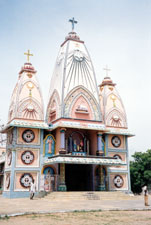Student uncovers Christianity in India

Andhra Pradesh is home of this colorful Catholic church. In this Church a mixture of Hindu and Catholic traditions can be seen. Inside, a statue of Jesus in an open lotus flower can be seen. The open flower represents immortality. Christianity first came to India with Thomas the Apostle.
Christianity in India has a much longer and richer history than I had ever thought.
In preparation for this research trip I was, of course, aware that 2 percent of Indians were Christian. What this statistic masks, however, is the concentration of this population in certain areas of the south is almost overwhelming. Arriving in Cochin, for instance, one of the first things taxi riders from the airport see is a large Catholic church and shrine to the Virgin Mary. This old church, though beautiful, does not prepare the visitor for the prevalence of Christianity in Kerala. Driving further into the downtown, it becomes obvious Christianity sets much of Kerala apart from the rest of India.
The history of Christianity in India is long and varied. It is a history that owes much to 16th century Portuguese explorers but also has an interesting connection to a much older time.
Thomas the Apostle, the “doubting Thomas” of the Christian New Testament, is believed by local legend, and by many historians, to have landed in what is now Kerala in 52 C.E. He is said to have established the Syrian Christian church that is still active in southern India and then made his way across southern India until his death near modern-day Chennai. There is a shrine dedicated to the Apostle’s landing place north of Cochin and a magnificent church where he is supposed to have died near Chennai.
Thus, there is Christianity in India that antedates the Roman Catholicism, and, indeed by all forms of Western Christianity. This suggests possibilities for Christianity that may be new or unfamiliar to us.
The culture of southern India’s Christianity is in some ways similar to that of Hinduism. The two faiths have adopted and blended traits from each other as they developed side by side. For example, in the Andhra Pradesh town of Nagarjunasagar there is a Catholic church that bears many similarities to Hindu temples. It is brightly and extravagantly colored with pillars and intricate designs. Flanking the entrance to the church are two statues, one of Mary and the baby Jesus, the other of St. Paul. The inside of the church is brightly colored with blues, reds, yellows and everything in between leaping off the walls. One can find a large crucifix bordered by blue neon lights. In fact, there may be more neon lights in that church than in all of Joplin.
Next to the church is a Hail Mary shrine, complete with a trough so devotees can wash their feet before entering. This custom of washing the feet is seen most often in Hinduism. It is a good example of the traits common to Hinduism and Christianity in India. Churches like this one (although none quite as extravagant) can be found elsewhere in India: they never cease to amaze.
Since the introduction of Christianity, there have been many converts from Hinduism for reasons similar to those that lead Hindus to convert to Islam. On the streets of Kolkata, one sees signs saying simply “Jesus Loves You,” and in these signs is perhaps the key to understanding why Christianity is attractive to so many Indians.
India is a country of 1.2 billion people. The dominant religion has not always fostered social equality among members of different castes. For many, the prospect of a god who knows your name, cares about you and sacrificed his only son for you is an attractive idea.
By the time I had left India, I had seen pontifical shrines hidden deep in palm tree forests and magnificent cathedrals from the earliest days of Portuguese trading and been allowed the pleasure of conversing with peace activists heading a Christian organization, founded by Christians, working toward religious understanding.
This long history of Christianity and its careful balance against India’s other faiths shows another aspect of religious coexistence.
Your donation will support the student journalists of Missouri Southern State University. Your contribution will allow us to purchase equipment and cover our annual website hosting costs.



























